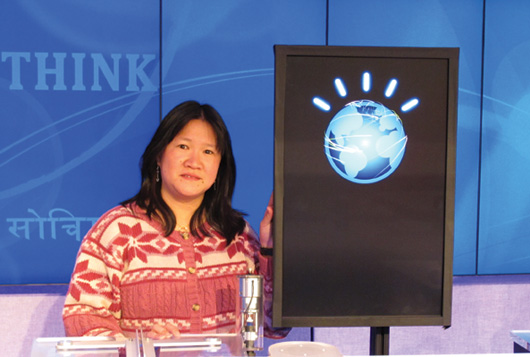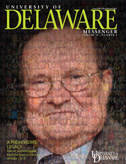
What is…a computer that can help doctors?
ALUMNI | Jennifer Chu-Carroll, EG96PhD, a researcher and manager at IBM’s T. J. Watson Research Center, never expected to help make history in demonstrating the power of computers. Yet in February 2011, television viewers watched the “Watson” computer, developed by the IBM research team that includes Chu-Carroll, defeat two human competitors on the popular quiz show Jeopardy!
Since then, the Watson team has been focusing on helping the supercomputing engine find a new job—as a physician’s assistant.
“We are very excited about applying the Watson technology in the medical domain,” says Chu-Carroll, who earned her doctoral degree in computer science at UD. “Obviously, IBM is not in the business of making game-playing computers. We used the Jeopardy! application to push the boundaries of what computers can accomplish and to demonstrate the advance in a way the public would understand.”
The project began more than four years ago, as Chu-Carroll and an innovative team of scientists created Watson, an analytical computing system that specializes in the analysis of natural human language to rapidly answer specific, complex questions.
Chu-Carroll’s work involved many aspects of Watson’s algorithmic development, focusing primarily in the areas of natural language processing and information retrieval.
“Computers were traditionally designed to understand instructions given to them in the language of computers,” she says. “Our work has been to help Watson understand information in human terms, setting the stage for future computers to increasingly be able to adapt and learn.”
This breakthrough technology signals a shift in computing that may have significant impact across many industries and in people’s daily lives, Chu-Carroll says. As a first step, the computer’s capabilities are being applied to help medical practitioners diagnose and treat patients.
“Ultimately, the doctors are the decision makers,” she explains. “Watson’s role is as a secondary source of information that can quickly augment a doctor’s knowledge.”
The supercomputing engine is aiming to sort through millions of pages of medical literature, textbooks, journals and experimental studies in mere seconds, while simultaneously cross-checking the data with a patient’s medical records, symptoms and test results in order to hypothesize what illness he or she may have.
Watson can also suggest tests to confirm or refute a diagnosis, and even ask questions to indicate when additional information is needed. If a doctor disagrees with the assessment, an interactive page can display how Watson arrived at its conclusion.
This real-time analysis has the potential to allow doctors and nurses to work smarter and faster, with greater accuracy, Chu-Carroll says, and to provide patients with individually tailored treatments.
“At UD, I learned research methodology—how to conduct, write and present my work to the research community,” she says. “That experience ultimately led me to IBM, where today I conduct interesting research that is relevant to business applications, in this case health care.”
Future applications for the Watson technology, she says, might include the legal, financial and business intelligence industries.
Article by Karen B. Roberts, AS90





